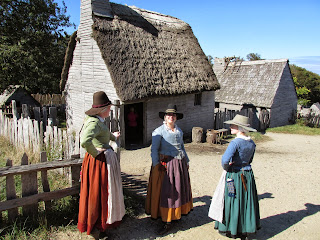The map on the side of our
camper is now full. Our criteria for
adding a state to the map is that we camped in the state AND experienced
something of the state—a museum, park, natural feature. Not shopping--we are not big gift shop or souvenir shoppers. Sorry, nobody gets any trip gifts--except a cool book for the grandsons sometimes.
Mystic Seaport is perhaps the
most impressive living museum we have ever seen. Historic sailing ships and buildings have
been acquired from the Connecticut to Massachusetts coast and reassembled and
restored at the site of a 19th century shipyard.
A keel from an old whaling ship. Don is standing at the other end of its 100 foot + length.
The Charles W Morgan, launched in 1841, is the only surviving wooden whaling ship from an industry that provided oil for lamps in the 1800’s. Her masts were being repaired, so this model is a better picture of her.
She has been completely restored in Mystic Seaport’s Preservation Shipyard which uses X-rays and other state of the art methods to analyze the original construction and the extent of damage.
Then ships are restored using the old methods
sometimes enhanced by modern technology to guarantee that the reconstruction is
authentic. The village has restored
buildings producing everything needed for the ships to operate. Sails are created in the sail loft mostly by hand
with some assistance from sewing machines over 110 years old. Barrels are made using old time tools in the
cooperage.
Wooden rings for the masts
are steamed and bent in the hoop shop. The shipsmith shop purifies bituminous
coal to make the pure carbon fuel needed to heat the forge where they make
whale harpoons and all the metal work needed for the reconstructions.
The shipcarver's
shop makes signs, decorative carvings, even ship figureheads. Ropes are made in a 250 foot long ropewalk
building by twisting fibers into strands and then twisting the strands into
heavy ropes as long as the building.
The Morgan completed 39 voyages over 80 years, each trip taking 3 to 5
years to process enough whale blubber into whale oil to fill all the barrels in
her hold. In the Pacific, reached by sailing
around the Horn, the whaling ships sometimes had to search a long time for the behemoths
they sought. Whaling dories manned by
six sailors fanned out from the ship to harpoon and kill a whale.
They towed it back to the ship where the
valuable parts were stripped out at the side of the ship by men on scaffolding.
The spermaceti, a liquid waxy substance used for
lubrication, candles, pharmaceuticals, cosmetics, and other uses, was gathered
from the head. Baleen, the flexible
plates in the whale’s mouth for filtering and catching food as water passes
through its mouth, was prized for corset stays, combs, and other products. The biggest use of the whale was the blubber,
cut off the body in heavy, thick strips, hauled aboard, cut into smaller pieces
and then cooked down into whale oil for lamps in iron kettles over a brick furnace right on the top deck.
During slow times on the long voyages, sailors would carve scrimshaw on whale teeth.
Mystic Seaport has a whole
village of rescued, restored buildings containing specialized museum
collections. The nautical instrument
shop has a collection of sextants, chronometers, and navigation tools second
only to Greenwich in England. The chemist
shop has old pharmaceuticals and an old ship captain’s medicine chest full of
medicines that might or might not cure various ailments the sailors could suffer. The figureheads building has an impressive
collection of carved wooden figureheads salvaged from old ships.
There are an original oyster house, a lobster
shack, a fish house, a lighthouse moved from Nantucket, a chapel, and
other display buildings.
Cod was cleaned and salted on the ship. Ashore it was soaked to remove some of the salt and dried on drying racks.
The harbor features a
remarkable collection of old restored ship, dories, fishing boats, training
ships for apprentices, and recreational sailing boats.






































































